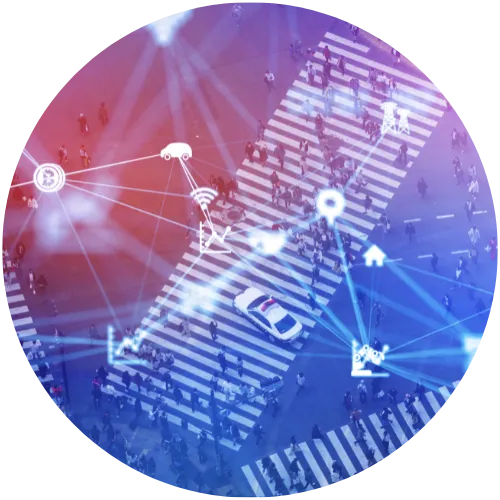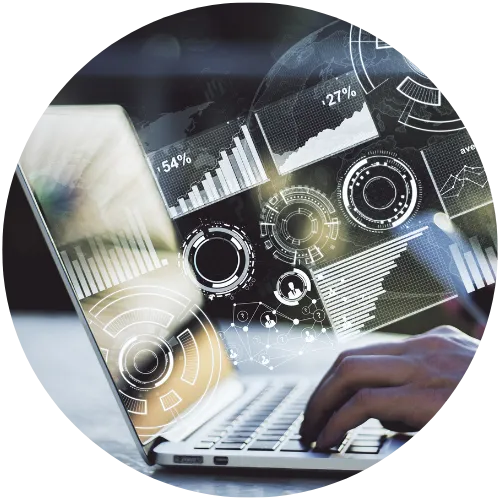The transportation sector must perpetually respond to emerging demands, playing a critical role in daily lives, economic vitality, and environmental wellness. Today’s transportation agencies across all levels of government are meeting this challenge by exploring innovative approaches to several priorities, including:
- Safety – Following three decades of a declining rate of roadway fatalities, the last decade has seen a pause in this downward trend. Further, according to a report by the U.S. Department of Transportation (USDOT), roadway fatalities increased in 2020.The department also notes that 95% of U.S. transportation network fatalities occurred on streets, roads, and highways. However, railway hazards are likewise a source of considerable concern. USDOT’s Federal Railway Administration reported 1,279 deaths resulting from 10,525 railroad crossing incidents in five years.

- Efficiency and Convenience – On average, commuters spend 54 hours per year either stalled or traveling at a crawling pace due to traffic. The congested road conditions driving this high idling rate impact the flow of trucks, private cars, and passenger transit vehicles alike, resulting in an estimated six billion gallons of fuel wasted annually by all road vehicles.
- Environmental Footprint – According to the U.S. Environmental Protection Agency, the transportation sector is the largest contributor to greenhouse gas emissions in the nation. A significant contributor to this pollution is idling. Engine idling of heavy-duty trucks alone releases an estimated 11 million tons of carbon dioxide, 55,000 tons of nitrogen oxides, and 400 tons of particulate matter into the environment in the U.S. each year. Hence, a robust decarbonization effort is mandatory if the U.S. transportation sector reaches the goal of net-zero greenhouse gas emissions by 2050.
Connecting the Dots for Improved Transportation
Innovative solutions are essential given the enormity of the issues that transportation agencies must tackle—and the immeasurable public interest in the outcomes of these efforts. Fortunately, technological advances offer promising approaches to the industry’s most significant challenges. AI-driven technologies empower transportation agencies to increase the effectiveness and immediacy of critical tasks, including monitoring traffic flow and safety, detecting maintenance issues, and assessing risks. By integrating data collected from multiple sources, agencies can perform advanced predictive and prescriptive analytics to inform accurate forecasts of roadway conditions and traffic volume, inform interventions, and aid in developing strategies for reducing carbon emissions.

Examples abound of data-powered tools and techniques driving improvements throughout the transportation industry:
- Intelligent Transportation Systems (ITS) are integrated technologies that connect multiple data sources to improve the speed and accuracy of detection, communication, and analysis of potential concerns. These sophisticated networks merge data from such sources as remote sensors and CCTVs to aid agencies in identifying and addressing roadway hazards and other safety concerns. ITS also increases agencies’ capacity to manage traffic flow, minimize idling, and optimize route planning for greater fuel efficiency and reduced emissions.
- AI-driven technologies can also improve railway safety. Enlisting the nearly ubiquitous CCTVs at railroad crossings to act as sensors, these tools can aid in real-time, continuous monitoring of video data. Assisting human monitors, who are subject to fatigue and can therefore miss hazards or incidents that impact safety, these tools enable increased supervision to inform more prompt and targeted intervention when dangers arise.
- Sensors collecting real-time data about the health of a vehicle help transportation agencies monitor the vehicle’s performance and condition. By contributing to the timeliness and effectiveness of maintenance, these technologies help agencies improve equipment safety and efficiency and aid them in identifying issues that impact the environment.
- Connecting passengers with seamless, multi-modal transit options, mobility hubs and MaaS (Mobility as a Service) platforms are emerging in some cities to offer accessible, digitally-driven travel itineraries that maximize the benefits of various transportation modes. These services personalize the experience of getting around town and optimize safety, convenience, and efficiency.
- As a welcome bonus, AI- and ML-powered technologies that lead to increased efficiency will also translate into cost savings for passengers.

A Data Savvy Workforce for Cleaner, Safer, More Efficient Travels
Technological advances are fueling progress in all areas of the transportation sector. As a result, the transportation workforce must be equipped with data literacy and data science skills across roles and functions to leverage these innovative capabilities. Training programs that provide industry-tailored learning pathways for learners at all stages of their data science journeys can help agencies upskill their personnel and meet the industry’s present and future challenges.

